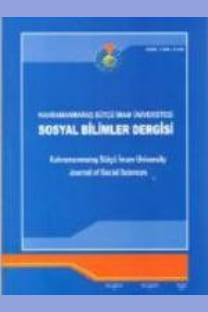Bir Üniversite Öğrenci Yemekhanesinde Simülasyon Modeli Uygulaması
Günlük hayatta sıra beklemek, oluşan müşteri kitlesine anında hizmet verememekten kaynaklanmaktadır. Beklemek müşterilerde memnuniyetsizliğe sebep olur, bu nedenle bekleme sürelerini dolayısıyla da memnuniyetsizliği azaltmak için hizmet sistemleri üzerinde çalışılması gerekmektedir. Beklemelerin en çok görüldüğü yerlerden bir tanesi de yemekhanelerdir. Özellikle üniversitelerde öğlen saatlerinde kısıtlı bir zaman diliminde çok sayıda öğrencinin yemekhaneden hizmet almak istemesi sonucunda uzun kuyruklar oluşabilmektedir. Bu çalışmada öğlen saatlerinde uzun kuyrukların gözlemlendiği bir üniversite öğrenci yemekhanesi için Arena simülasyon yazılımında mevcut durum için model kurulmuş, mevcut durum incelenerek beklemeleri azaltacak alternatif senaryolar geliştirilip denenmiştir. Yoğun bir günde öğrenciler sistemde 40 dakika geçirmekte ve bunun 17 dakikası beklemekle geçmektedir. Alternatif senaryolar ile bu durumun iyileştirilerek sistemde geçirilen sürenin 24 dakikaya, bekleme süresinin ise 1 dakikanın altına indirilebileceği tespit edilmiştir.
Simulation Model Application In A University Student Refectory
The reason for waiting in the daily life is due to the inability to provide instant service to the customer. Waiting leads to dissatisfaction with customers, so it is necessary to work on service systems for reducing waiting times. One of the places where waiting is observed most is the refectory. Especially in universities, long queues may occur as a result of the large number of students willing to get service from the refectory in a limited time period. In this study, a model was established for the current situation in Arena simulation software for a university student refectory where long queues were observed at noon hours, current model examined and the alternative scenarios that would reduce waiting time were developed and tested. On a busy day, students spend 40 minutes in the system and 17 minutes of it passes by waiting. It was determined that the time spent in the system can be reduced to 24 minutes and the waiting time below 1 minute by improving this situation with alternative scenarios.
___
- Adi, E. ve Dharmawirya, M. (2011). Case study for restaurant queuing mode, International Conference on Management and Artificial Intelligence IPEDR, 7, 52–55
- Akdeniz, H. A., B. Tatar (2009). Havalimanında kuyruk simülasyonu: İzmir-Gaziemir Adnan Menderes Havalimanı uygulaması, Dokuz Eylül Üniversitesi Sosyal Bilimler Enstitüsü Dergisi, 11(3), 3-12, İzmir.
- Arpacı, S. S. (1995). Konut projelerinde simülasyon yaklaşım ile maliyet tahmini, [Yüksek lisans tezi], İstanbul Teknik Üniversitesi.
- Chou, C. Y., and Liu, H. R. (1999). Simulation study on the queuing system in a fast-food restaurant. Journal of Restaurant & Foodservice Marketing, 3(2), 23-36.
- Church, I., and Newman, A. J. (2000). Using simulations in the optimisation of fast food service delivery. British Food Journal, 102(5-6), 398-405.
- Curin, S. A., Vosko, J. S., Chan, E. W., and Tsimhoni, O. (2005, December). Reducing service time at a busy fast food restaurant on campus. In Proceedings of the 37th conference on Winter simulation (pp. 2628-2635). Winter Simulation Conference.
- Çevik, Y. ve Yazgan, A. E. (2008), Hizmet üreten bir sistemin bekleme hattı(kuyruk) modeli ile etkinliğinin ölçülmesi, Niğde Üniversitesi İktisadi Ve İdari Bilimler Fakültesi Dergisi, 1(2), 119-128.
- Gupta, N., and Williams, E. J. (2004). Simulation improves service and profitability of an automobile service garage. In Proceedings of the 16th European Simulation Symposium.
- Halaç, O. (1993), İşletmelerde simülasyon teknikleri, Alfa Basım Yayım.
- He, H. and Hu, Z. (2018, July). Analysis of fast food service capability based on flexsim modeling and simulation. In IOP Conference Series: Materials Science and Engineering, 394(5), p. 052005). IOP Publishing.
- Kelton, W. D., Sadowski, R. P., and Sturrock, D. T. (2007). Simulation with arena. 4th Ed. McGrawHill.
- Koruca, H. İ., Aydemir, E., Oktay, A., ve Uğurlu, N. (2011). Isparta ili elektrik arıza tamir bakım biriminde simülasyon destekli personel planlama ve organizasyon yapılandırma araştırması. Süleyman Demirel Üniversitesi Fen Bilimleri Enstitüsü Dergisi, 15(3), 218-223.
- Kharwat, A. K. (1991, December). Computer simulation: an important tool in the fast-food industry. In Proceedings of the 23rd conference on Winter simulation (pp. 811-815). IEEE Computer Society. Laughery, R., Plott, B., and Scott-Nash, S. (1998). Simulation of service systems. Handbook of Simulation, 629-644.
- Law, M. A. and Kelton, D. W. (2000), Simulation modeling and analysis, McGraw-Hill, USA.
- Lee, K. W., and Lambert, C. U. (2006). Using simulation to manage waiting time in a cafeteria. Information Technology in Hospitality, 4(4), 127-141.
- Lee, C. K., Zhang, S., and Ng, K. K. (2019). In-plant logistics simulation model for the catering service industry towards sustainable development: A case study. Sustainability, 11(13), 3655.
- Muslu, I., Jakshylykov, J., Soorbekova, B., Kutmanova, U., and Musiralieva, M. (2014). Restaurant process simulation in Kyrgyzstan. In 2014 11th International Conference on Electronics, Computer and Computation (ICECCO) (pp. 1-4). IEEE.
- Nettles, M. F., and Gregoire, M. B. (1997). Use of computer simulatıon ın school foodservıce. Foodservice Research International, 9(3), 143-156.
- Özdağoğlu, A., Yalçınkaya, Ö., ve Özdağoğlu, G. (2009). Ege bölgesi’ndeki bir araştırma ve uygulama hastanesinin acil hasta verilerinin simüle edilerek analizi, İstanbul Ticaret Üniversitesi Fen Bilimleri Dergisi, 8(16), 61-73.
- Söyler, H., ve Ali, Koç. (2014). Bir kamu hastanesi için acil servis simülasyonu ve veri zarflama analizi ile etkinlik ölçümü. Aksaray Üniversitesi İktisadi Ve İdari Bilimler Fakültesi Dergisi, 6(2), 115-132.
- Şahin, M. (1978), Üretim yönetiminde simülasyon analizi ve uygulaması, Eskişehir İktisadi ve Ticari İlimler Akademisi.
- Tan, W., Xu, W., Yang, F., Xu, L., and Jiang, C. (2013). A framework for service enterprise workflow simulation with multi-agents cooperation. Enterprise Information Systems, 7(4), 523-542.
- Uyrun, A. ve Yıldız, M. S. (2015). Hızlı yiyecek içecek işletmesi servis sisteminin bekleme hattı modeliyle analizine yönelik bir uygulama, Atatürk Üniversitesi İktisadi ve İdari Bilimler Dergisi, 29(1), 19-34
- Yıldız, M. S. ve Arslan H.M. (2013), Bekleme hattı modeliyle servis sisteminin analizi: düzce üniversitesi merkez yemekhanesi örneği, Yönetim ve Araştırma Dergisi, 21, 169-184.
- ISSN: 1304-8120
- Yayın Aralığı: 3
- Başlangıç: 2004
- Yayıncı: Kahramanmaraş Sütçü İmam Universitesi
